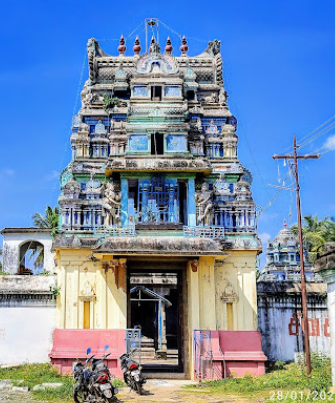The name Kanraappur is derived from several words: Kanru (cow’s calf), Aappu (wedge to which the calf is tied), natuthari (positioned wedge), and thari (wedge). The history of this temple begins with Lord Shiva and His consort, Uma Devi, who resided on Mount Kailash while the Devas, led by Lord Brahma, were engaged in the act of creation. During this time, Sudhavalli, a celestial maiden, took on the form of Goddess Uma to please the Lord. However, Goddess Uma became angry upon seeing Sudhavalli's impersonation and cursed her to be born on Earth.
Feeling remorseful and fearful, Sudhavalli received a boon from Goddess Uma, allowing her to worship Lord Shiva on Earth before returning to their heavenly abode. Thus, Sudhavalli arrived in southern Tamil Nadu, specifically in a sacred area in Thevur, where she was born into a hereditary Saiva Vellala family and grew up as Kamalavalli, a devout girl filled with Sivajnana. Raised in the Saiva tradition, she continually worshipped Lord Shiva, rekindling her devotion from her previous life.
Upon reaching marriageable age, her parents arranged a marriage for her, and she moved into a separate home with her husband. Like Karaikkaal Ammaiyar, Kamalavalli expressed her love for Lord Shiva through her devotion and performed all the righteous duties for her divine beloved. However, her husband, unaware of her piety and harbouring disdain for her Shiva worship, discarded the Shiva Lingam by throwing it into a well. Conflicted about whether to continue her worship against her husband's wishes, Kamalavalli decided to use the wedge to which the calf was tied as a substitute for the Shiva Lingam.
When her husband discovered her secret devotion, he struck the wedge with an axe, causing blood to flow from it. To reveal Kamalavalli’s unwavering faith, Lord Shiva manifested as a Lingam within the wedge. Both Kamalavalli and her husband attained mukti (liberation) and reached Lord Shiva’s abode. As the wedge transformed into a Lingam, the place became known as Kanraappur. Despite the Lingam appearing as a swayambhu murti (self-manifested deity), the Lord came to be known as Natutharinaathar, reflecting His emergence from the wedge. Today, the axe injury is still visible on the head of the Prime Deity.
Additionally, an asura named Itumpan worshipped Natutharinaathar at this holy site and received blessings.
Sthala Puranam :
In Kailasam, Sudhavalli, a Vidyadhara girl, captivated Lord Shiva and Goddess Parvati with her dance. During her performance, she imitated Parvati, which offended the goddess. In response, Parvati cursed Sudhavalli to be born on Earth. Upon Sudhavalli's pleas, the curse was modified, allowing her to continue her devotion to Shiva. Consequently, Sudhavalli was born into a Saivite Velalar family but later married into a Vaishnavite family. Despite her husband’s beliefs, she steadfastly worshipped Lord Shiva.
One day, when her husband discovered the Lingam she used for worship, he grew angry and threw it into a well. Determined to continue her worship, Sudhavalli began to pray to a wooden peg used to tether their calf, imagining it to be a Shivalingam. When her husband saw this as well, he took an axe to strike the peg. To his astonishment, as he struck it, the peg transformed into a Shiva Lingam, and blood began to flow from it. Ultimately, Lord Shiva emerged from the Lingam, granting Sudhavalli and her husband liberation, or Sivalokam, despite his initial disdain for Saivism.
Vidyadharas (literally "holders of wisdom") are a class of celestial beings known for their education and magical abilities, often serving Lord Shiva and Parvati in Kailasam.
The temple's name, Nadu-Thari, refers to a peg in the ground used for tethering cattle. In Sanskrit, Lord Shiva is referred to as Vatsa-Sthamba Nathar, with "vatsa" meaning young calf and "sthamba" meaning peg or pillar. The place was originally named Koil Kandru-Aappur (where "kandru" means calf and "aappu" refers to a peg). The cowshed where Sudhavalli worshipped the peg is believed to be the site of the current temple. The Shiva Lingam is said to bear a scar from her husband's axe.
The Sthala Vriksham (sacred tree) of this temple is the Kal Panai, a rare variety of palm tree found only in this region.
This temple is regarded as more powerful than many other Shiva temples, including those in Kalahasti, Chidambaram, Keezh Velur, and Nagai Karonam. It is believed that visiting this temple twice is equivalent to worshipping at all Shiva temples worldwide. Furthermore, simply walking through the village bestows the benefits of residing there and praying to Shiva at this temple.
All lands in this village are owned by Lord Naduthariappar, as recorded in the patta documents, with no individual private ownership.
The temple is a prarthana sthalam (place of prayer) for those with eyesight issues, which may have contributed to the name evolving into Koil Kannappur (with "kannu" meaning eye in Tamil).
While the temple dates back to the Chola period, extensive renovations have been carried out by the Nagarathar community in recent decades. The temple architecture features unique aspects, such as the Nandi and Bali Peetham located on a raised platform at the entrance. The temple boasts stunning sculptures and bas-relief images, with a particularly beautiful depiction of Dakshinamurti surrounded by rishis in the Koshtam. Notably, Appar and Adhikara Nandi flank the Lord. Along the perimeter of the upa-pitham surrounding the garbhagriha, the 63 Nayanmars are depicted in miniature. One of the names of the goddess here is Valli Nayaki, which is traditionally associated with one of the consorts of Murugan.
Administration History :
The temple is administered under the auspices of the Hindu Religious and Charitable Endowments Department of the Government of Tamil Nadu. Historically, it has been maintained by the Nattukottai Nagarathars, who have played a significant role in its upkeep. Their contributions include renovations and the establishment of community services like Annadhanam. The temple's administration has focused on preserving its heritage while ensuring it serves the spiritual needs of devotees.
